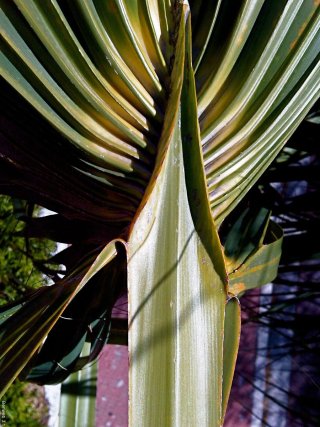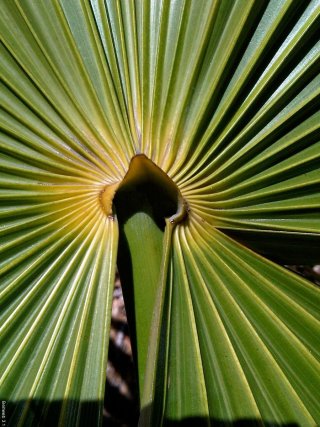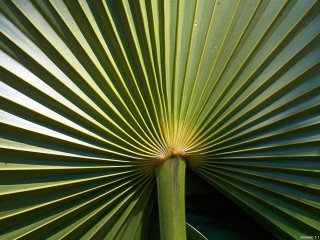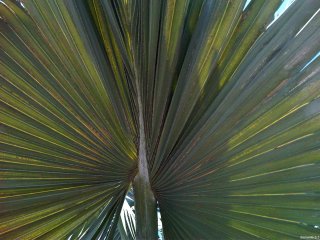Today’s word is a botanical term, hastula, which I assume originates from the Latin hasta, spear. I can only assume it because I don’t know it for a fact. None of my desk references, not Merriam-Webster’s Collegiate, not the “unabridged” American Heritage 4th edition, not even the venerable Oxford English Dictionary admit the term into the language. Even the online OED gives me this sad result:

So, what to do now? Well, go back to the book in which the hard word arose. In this case, it’s Wunderlin and Hansen’s Guide to the Vascular Plants of Florida, 2nd edition. There, we see its use in botanical description of the leaves of Sabal palmetto, the cabbage palm:
Leaf blades triangular, held in a V with a downward curve, the costa extending fully or nearly the length of the undivided portion of the blade, the hastula acute to attenuate, the margin with long free fibers.
Ah-ha. Mm-hm. As I suspected. No help here. It’s got something to do with the leaves, or the leaf blades, but context really isn’t helping.
A quick Google search, though, turns up a nice definition from an article on invasive exotics in Hawai’i:
hastula In some palmate palm fronds, a flange of tough material on the upper side of the petiole where it joins the frond blade
That helps. So does this rather more technical definition from A Revised Classification of Fossil Palm and Palm-like Leaves, by Robert W. Read, Leo J. Hickey, which appeared in Taxon, Vol. 21, No. 1 (Feb., 1972), pp. 129-137:
A ligule-like structure (hastula) at the apex of the petiole (usually only on the adaxial surface, rarely on both surfaces) where the radiating segments are inserted on the palmate blade.
Now, if I only knew what a ligule was, I’d be in business. After all, if two respected scholars like Read and Hickey tell me that a hastula is ligule-like, well, that’s good enough for me! But here the editors of MW11e are kind to me, and explain that a ligule is
a scalelike projection esp. on a plant: as a: a thin appendage of a foliage leaf and esp. of the sheath of a blade of grass.
Whew. What a relief! Aren’t you glad to know that a hastula is like a scalelike projection on a plant? Sometimes learning about words can feel like you’re caught, like Eloise, on that gigantic traffic circle around the Arc de Triomphe:
And to come, ahem, full circle, i.e., return to the information about Sabal palmetto in Wunderlin and Hansen that I was looking up, it’s obvious that the shape of the scalelike projection known as a hastula can vary. In the cabbage palm, its form is “acute to attenuate.”
Geometrically, of course, an acute angle is one smaller than 90°. In nonmathematical terms, of course, acute means, “ending in a sharp point.” Botanically, I suppose, it means pretty much the same thing.
And here is what MW has to say about attenuate:
at·ten·u·ate \ə-ˈten-yə-wət, -yü-ət\ adj [ME attenuat, fr. L attenuatus, pp. of attenuare to make thin, fr. ad- + tenuis thin] (15c). tapering gradually usu. to a long slender point <~ leaves>
So the hastula of the cabbage palm is acute to attenuate, and looks something like this:
I think, given the photographic evidence, that I am justified in deducing that the word hastula has the same origin as hastate, which does indeed come from the Latin hasta, spear.
Below is another form the hastula can take, much more rounded. It’s from a different species of palm, one I have yet to identify:
And this final version of the hastula is even less spearlike than the last; it’s just a thin strip of plant tissue that separates the petiole/stalk from the palm leaflets/fingers:
So I’m not too solid on the derivation of the word, but my guess is that the first ones described were indeed spearlike, and the name stuck, even though, as the pictures above prove once again, etymology doesn’t dictate to nature.
In case you were wondering about that one-sidedness of the hastula that Read and Hickey discuss, well, here’s what it translates to in images:
See, no hastula on the adaxial side of the frond; if you want to see it, you have to turn it over and look at the abaxial part.






Thank you for sorting this out for me. I am always looking for explanations about palms.
Gayle
Under the entry “Chuniophoenix hainanensis” in “The Palm Identifier” by Martin Gibbons, 1996, the leaf is described as having “no hastula, a feature which distinguishes it from almost every other palm”… I wonder if he meant “every other palmate/costapalmate palm”, and also if the hastula serves or ever served a purpose. This fossilised palm from Shingbuk in eastern Ladakh in northern India also seemed to lack a hastula: http://www.academia.edu/5770948/A_new_fossil_palm_leaf_from_the_Hemis_Formation_of_Ladakh_Jammu_and_Kashmir
Good question. There must be more to the hastula than I was able to uncover in my brief researches on the term, because I certainly wouldn’t expect “almost every other palm” to have one, as your quote from Gibbons implies that they must.